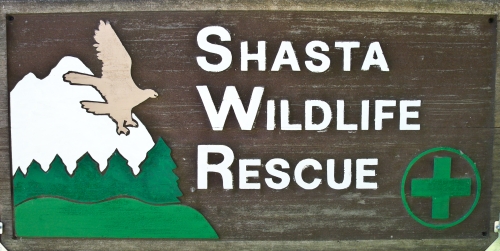
Wildlife rehabilitation is essential to return wild animals that have been injured or orphaned, due to human activity or natural disaster, back into the wild. It is an important aspect of protecting wild animals, biodiversity and the environment in our ever expanding human sprawl.
Luckily the folks in Shasta County can count on an excellent local, nonprofit organization that was founded in 1979, Shasta Wildlife Rescue and Rehabilitation (SWRR).
This is a pair of juvenile Red-tailed Hawk siblings in the flight enclosure built in 1992, nearly ready for release into the wild.
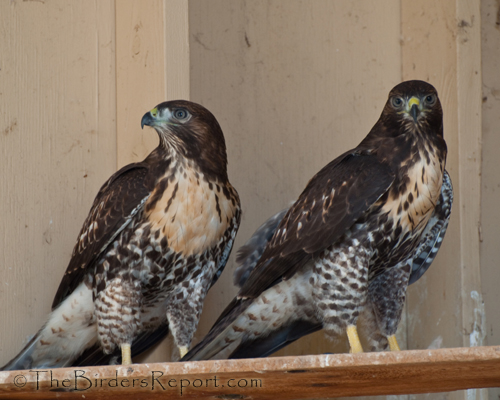
The flight enclosure was the first stop on the tour of the facility, given to me by Lynda Flaherty, one of the organizations longest standing volunteers and coordinator of their “Art On The Wild Side” fundraiser. The enclosure was built by volunteers and greatly enhanced strength and endurance conditioning for large raptors prior to their release.
Some of the other raptors currently being rehabilitated at the facility were a couple of Red-shouldered Hawks
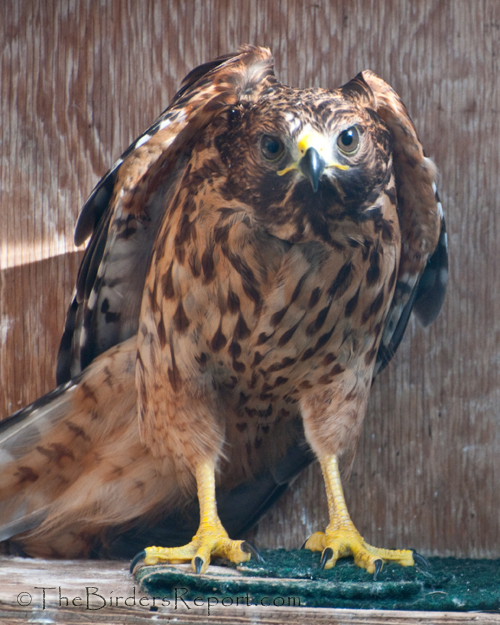
a Peregrine Falcon
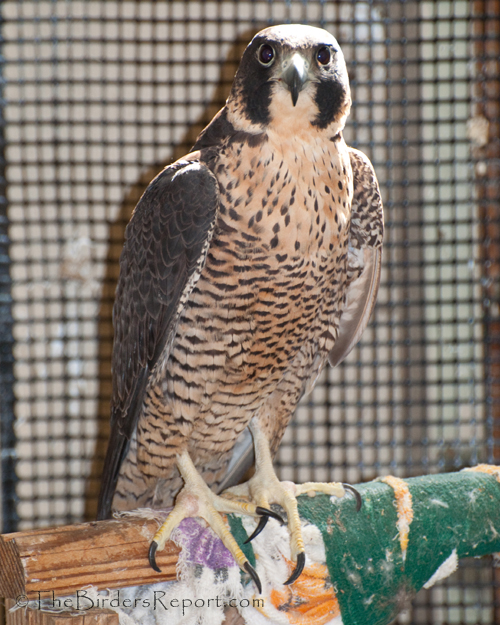
and a young Great Horned Owl
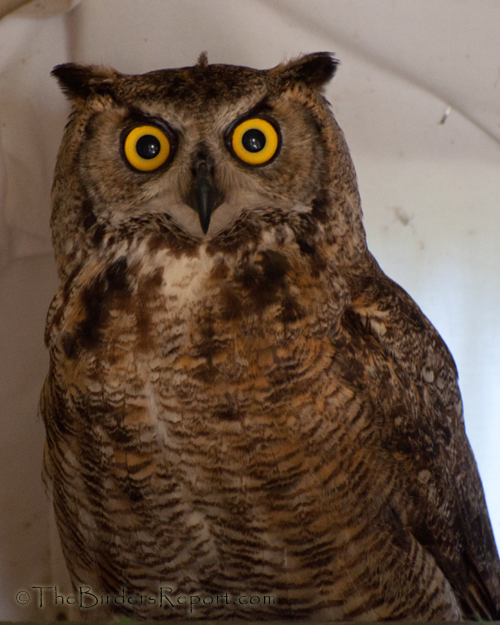
This organization is run by a dedicated group of volunteers that work 12 hours a day, 7 days a week from mid-April until the end of August. They take in hundreds of injured and orphaned animals that they painstakingly rehabilitate and release back into the wild.
Some of these volunteers work more than their regular four hour shift because to keep a facility like this open 12 hours a day, it would take something like 97 active volunteers to fill all the shifts during the busy Spring and Summer seasons.
Baby birds that are brought in are evaluated and moved to the proper location for a feeding regime depending on condition, age and diet. A strict diet protocal is in place to put birds on track for a speedy recovery and release.
The food, usually given by syringe or on the end of a stick, is mixed up in their kitchen. Those are the diet recipes and instructions up on the wall with the green borders.
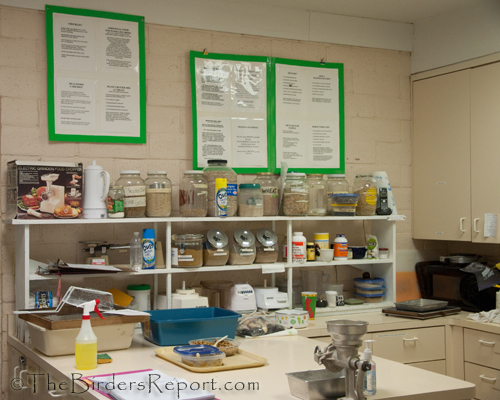
These are, I believe, Western Scrub-Jay nestlings that are still in the incubator phase, when they must be fed every 10 – 15 minutes
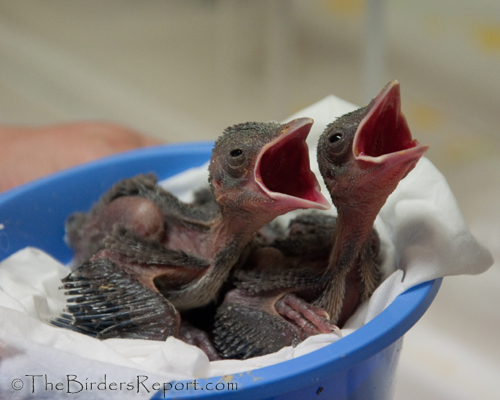
and a nest of feathered sparrows that are nearly ready to move to the next stage of learning to eat on their own where they are fed about every thirty minutes.
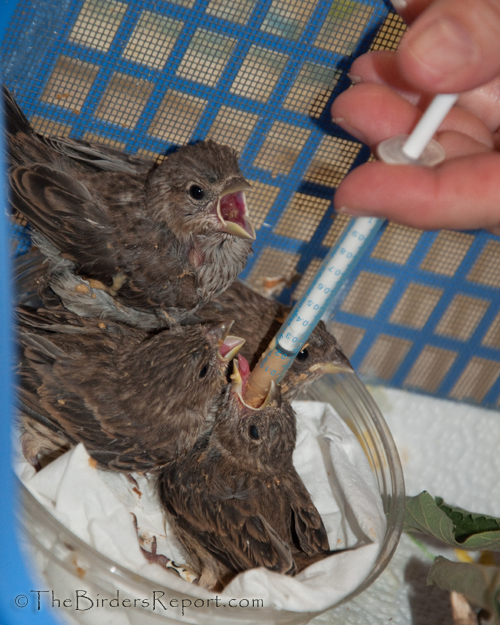
This American Robin nestling being tended by Taylor, one of the youngest volunteers, is just about ready to move to the “learn to eat on your own” flight room
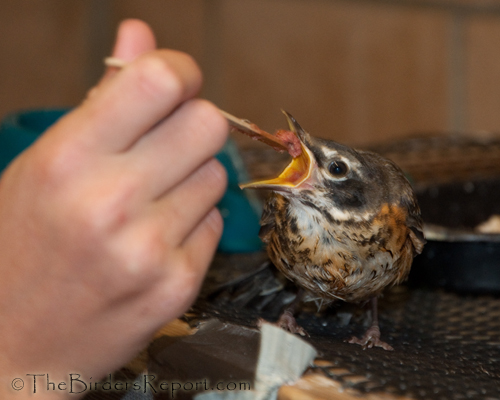
and below is a male Northern Flicker (red shafted) that was compromised when its nest tree was unknowingly cut down. The conscientious owners brought the nestlings to SWRR where they will surely be able to return to the wild when they are ready.
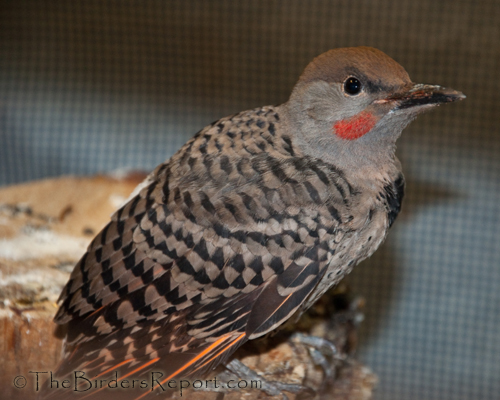
Here is a short video tour of the facility
Shasta Wildlife Rescue and Rehabilitation also has a foster care program. The birds that are in their Educational Program very often also act as Foster Care Parents for young, orphaned birds of the same species. They are put in the same aviary as the adult Ed bird and the Ed bird takes over as the parent.
They raise up the orphans and also show how the young should behave as part of their particular species. Since the Ed bird usually can’t fly and hunt on it’s own, when it’s time for the young to start hunting, they are moved to the wildlife center and given live food to start their hunting lessons.
I was fortunate to meet Betty, Captain and KeHwani, the Great Horned Owl’s handler. She is one of the many volunteer handlers that houses these precious animals so that people in the community can learn about wild animals.
This is one of the many owlets currently being fostered by Captain and KeHwani
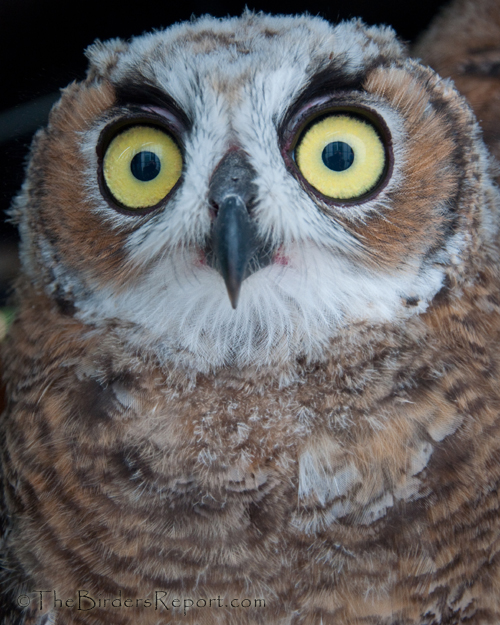
Shasta Wildlife Rescue and Rehabilitation can always use donations and volunteers. 100% of donations go to wildlife rescue. That’s right 100%! This organization is entirely run by volunteers.
If you can help with a donation or have time to volunteer (remember, they need 97 volunteers to cover all the shifts during the summer season), please give them a call or go to the volunteer page for more information.
You can find a wildlife rehabber in your area, listed by state, here. Please support your local wildlife rehabber!
After reading Wandering Weeta’s post on the Orphaned Wildlife Rehabilitation Society, I wanted to give you a link to her post, A Visit to O.W.L., in case you want to donate to her cause in British Columbia.
An if you want to see some excellent bird photos, check out Bird Photography Weekly.









Comments on this entry are closed.
It certainly takes dedication to successfully raise those young birds and then return them to the wild. Great work!
.-= Mick´s last blog ..Another Common Bird =-.
Thanks for that great write up Larry, not to mention the close up photos. those folk are sure doing a great job
.-= Phil´s last blog ..Top O The Morning =-.
Kudos to the volunteers. They do a great job. Thanks for the excellent report and pics, Larry.
It is awesome to have these rehab places and the great people who work there. Your tour of the Shasta wildlife rescue are wonderful.
.-= Eileen´s last blog ..Bombay Hook NWR =-.
Great photos! I love the expression of the hawks. Must be fun to work with all these birds.
Awesome photos and videos Larry! I am always in awe at the work the rehabilitators do.
.-= MaineBirder´s last blog ..BPW- Maine Shorebirds =-.
Rehabbers are saints. Truly.
.-= Wren´s last blog ..homestead myworld =-.
@Mick you’re right on there. These folks are some of the most dedicated people I’ve ever met.
@Phil thank you. I am proud to be a supporter of such a great organization
@Gwen you are very welcome. Thanks for stopping by
@Eileen I don’t know what we would do without them
@Halcyon I love the raptors and these people save many every year
@John I am in awe of them too. The videos are theirs and I thank them
@Wren you hit the nail on the head, they are saints!
This was an interesting tour. It gives hope somehow when you see that people actually cares. Great photos of beautiful birds. 🙂
.-= NatureFootstep´s last blog ..Gone birding and swimming =-.
You are right: very important work! … and a good place to learn about birds, too.
What a great organization, with a very extensive facility. I am glad that there are places like this operating at such a capacity.
.-= sciencedude288´s last blog ..7-4-10—32C—Alajuela- Costa Rica =-.
Love the tour – really helps people understand the level of work and dedication that volunteers provide in order to care for wildlife. Excellent!
I remember going to the wildlife rescue center and seeing all of the different birds and animals they had rescued from fires or different disasters that happened. This place even had a bald eagle that was injured. It was really interesting to see one up close and personal. They are very majestic. I was very jealous that my job didn’t deal with rescuing animals in need that would otherwise die.